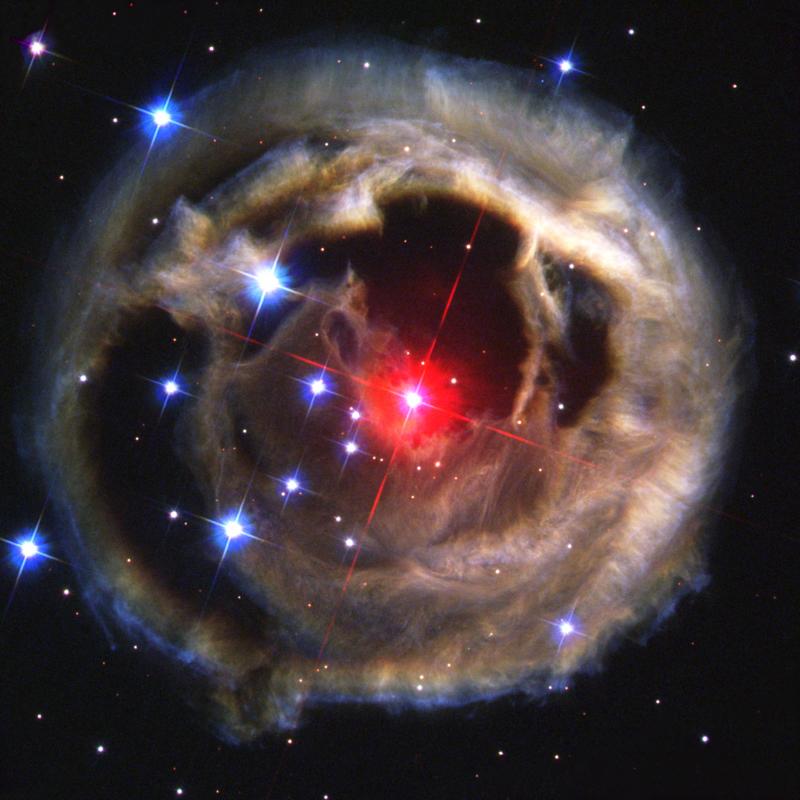







| BOOKS | F. A. Q. | ARTICLES | TALKS | ABOUT KEN | DONATE | BEYOND OUR KEN |
|---|
By Ken Croswell
Published on New Scientist (October 21, 2016)

A red nova from 2002. Credit: Hubble Space Telescope. NASA and the Hubble Heritage Team (STScI/AURA).
A dim binary star named KIC 9832227 is behaving exactly as expected if it is about to explode as a "red nova." If that happens, in 2022 or so it could shine as brightly as the North Star.
Dozens of ordinary novae – the temporary flare-ups of white dwarf stars stealing gas from their companion star – explode in our Galaxy every year. These novae turn blue.
In recent years, however, astronomers have discovered a rare type of nova that turns red instead. At peak brightness, many red novae rival the most luminous stars in the Galaxy.
A red nova in 2008 gave us a clue as to why these explosions happen: observations made before the blast revealed that the nova was the result of two stars orbiting each other merging into one.
The two stars were in a so-called contact binary, orbiting so closely that they touched. If Earth circled a contact binary, our Sun would look like a fiery peanut.
Despite their exotic appearance, contact binaries are common, with nearly 40,000 known in our Galaxy. Now new observations show that one, named KIC 9832227, could be about to explode as a red nova.
Boom star
“My colleagues like to call it the ‘Boom Star’,” says Larry Molnar of Calvin College in Grand Rapids, Michigan.
The binary is roughly 1700 light-years from Earth in the constellation Cygnus. The two stars whirl around each other every 11 hours.
In 2013 and 2014, Molnar’s team discovered two things about KIC 9832227 that suggest an imminent explosion: the orbital period is decreasing, and it’s doing so at an ever-faster rate.
This is exactly what the contact binary that sparked the 2008 red nova did. The orbital period shrank because the two stars circled each other faster as they spiralled closer together.
Unfortunately, other effects can mimic this decrease in orbital period. For example, a third star can pull the binary toward us so that its light takes less time to reach Earth, creating the illusion that the two stars are circling each other faster. So additional observations were needed to figure out what KIC 9832227 was likely to do.
In late 2015, astronomers in Bulgaria observed the star with a 30-centimetre telescope and found that the star's period is still shrinking at an ever-faster clip. “A stellar merger is a real possibility,” says Alexander Kurtenkov of the University of Sofia.
Molnar’s team finds this trend persisting into 2016. “At this point, I think we have a serious candidate,” he says.
His latest observations, made with 40-centimetre telescopes in Michigan and New Mexico, put the date of the potential explosion between 2021 and 2023. But he cautions that another three years of observations are required before he can rule out alternatives. By then, if the orbital period keeps shrinking faster and faster, an impending explosion will be very likely. If it calms down, there might be a different outcome.
KIC 9832227 is currently 12th magnitude – visible only through a telescope. But if it brightens by 10 magnitudes, as the 2008 red nova did, it will be as bright as the North Star and the brightest stars of the Big Dipper, and easily visible to the naked eye.
Update (September 7, 2018): New work indicates the predicted merger will NOT occur and the star will NOT explode.
Ken Croswell earned his Ph.D. in astronomy from Harvard University and is the author of The Alchemy of the Heavens and The Lives of Stars.
"An engaging account of the continuing discovery of our Galaxy...wonderful." --Owen Gingerich, The New York Times Book Review. See all reviews of The Alchemy of the Heavens here.
"A stellar picture of what we know or guess about those distant lights."--Kirkus. See all reviews of The Lives of Stars here.
| BOOKS | F. A. Q. | ARTICLES | TALKS | ABOUT KEN | DONATE | BEYOND OUR KEN |
|---|